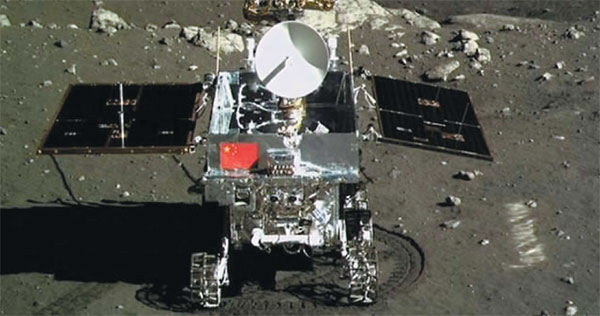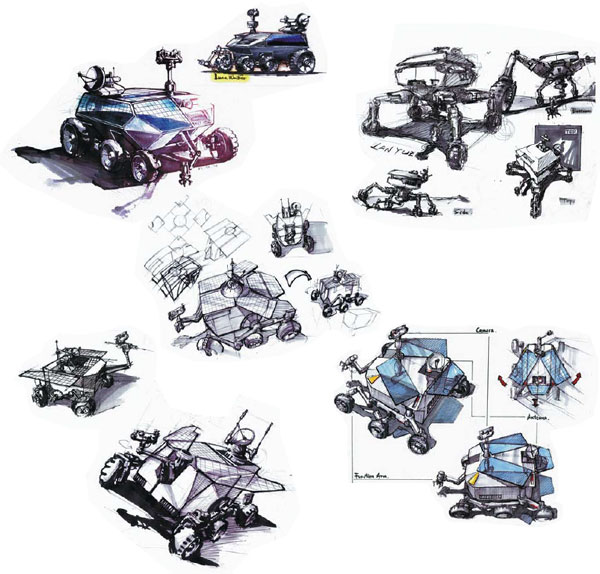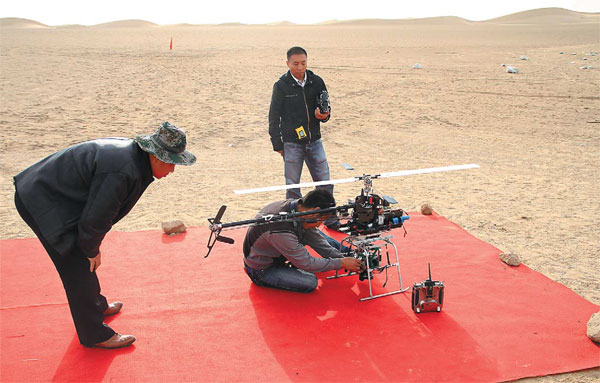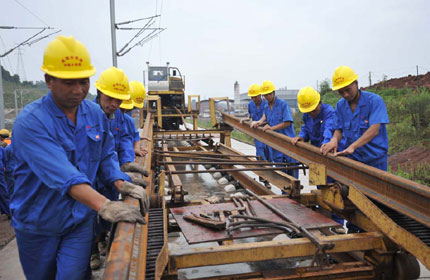Birth of the Jade Rabbit
Updated: 2014-07-04 08:13
By Yu Fei and Yu Xiaojie (China Daily Europe)
|
|||||||||||
|
The Yutu rover working on the moon. Provided to China Daily |
|
Cartoon depictions of moon vehicles that resemble Yutu. Provided to China Daily |
The development of China's first moon rover could mark the start of a 20-year golden age for space exploration, Scientists say
When young Chinese space scientists began designing the country's first moon rover, Yutu, or Jade Rabbit, their first drawings could well have been taken from a textbook of elementary geometry.
Would it be a four-wheeled, six-wheeled or eight-wheeled rover with rectangular, triangular or trapezoid shaped solar panels?
What emerged was the condensed wisdom and diligence of hundreds of researchers who spent a decade in its design and production.
In July 2004, Jia Yang, a researcher with the China Academy of Space Technology, drew three overlapping circles, representing spacecraft, vehicle and robot.
"The moon rover concept was at the intersection of the three circles. The biggest difference between a moon rover and other spacecraft was that it would interact with the moon's surface," Jia says.
At the start of China's Chang'e lunar exploration program in 2004, more than a dozen research institutes and universities vied to take part in the development of the lunar rover.
They had many designs: some moved fast; some had deft robotic arms; others could overcome big obstacles.
Eventually, more than 100 institutes and research agencies joined the project, and the lunar rover ended up as a combination of technologies from various sources, says Jia, who became deputy chief designer of the Chang'e-3 lunar probe in 2008.
"We studied many foreign documents to understand the basic research. But when we met difficulties, we could only rely on ourselves," Jia says.
According to a fellow deputy chief designer, Zhang Yuhua, of Shanghai Academy of Spaceflight Technology, China and the United States did not work together on lunar exploration.
The initial blueprint featured a rover with a cube-like body, which some critics likened to an ice-cream vendor's trolley.
The designers came up with many different shapes, but chose the most feasible in terms of technology.
"Since we had many restrictions, such as its weight, we kept the design simple to meet all the functional demands," Jia says.
"Maybe some thought the moon rover was not pretty, but it was perfect in our eyes because it met all the technological requirements."
The different design stages reflected its evolution.

The rover's body transformed from that box to a complicated shape enveloped by cooling panels.
The wheels were connected in different ways, the previously folding solar panels on each side became one foldable structure with one fixed, and the antenna and the pole holding the cameras were combined.
Experts and designers pondered every conceivable question, but one that preoccupied them more than most was whether the rover could right itself if it tipped over.
"After many trials, our conclusion was no, it couldn't. If the delicate equipment on the rover, as well as the solar panels, were covered with lunar soil, they could not work," Jia says.
"So we could only consider how to keep the rover from overturning in the first place."
Animated discussion followed. After deciding on a six-wheel rover, designers looked for months at two plans to connect the three wheels on each side.
Plan A had only a strong forward movement, while computer simulations showed plan B had a better ability to move in reverse.
Researchers imagined two basic scenarios: when the rover crossed a small obstacle, and then when it faced an insurmountable one.
If it hit the second, it had to retreat. If they chose plan A, the rover could have problems too. But eventually, plan B was chosen.
Long before the launch of the lunar probe, Jade Rabbit's weight also troubled developers.
Designing the prototype, researchers were required to keep its weight within 120 kilograms, due to the rocket's capacity.
The rovers developed by the former Soviet Union were more than 700 kg, while those of the United States were more than 200 kg.
"At the beginning, many veteran specialists thought it was impossible to make such a light vehicle. And even if we made it, would it be unreliable, they asked," Zhang Yuhua says.
They tried everything to reduce its weight: The antenna and the pole holding the cameras were combined; they changed from two foldable solar panels to one fixed and one folding, which took off 500 grams; several instruments were replaced with integrated electronic devices, cutting another 20 kg, and even the amount of soldering and the number of screws were discussed and tested.
Little by little, Yutu's weight fell from 200 kg to its final 136 kg.
Experience gained from reducing the weight, such as the multi-functional design of the solar panel and the integrated electronic technology, could be adapted for future spacecraft, Jia says.
One night on the moon is about 14 days on Earth, during which the temperature falls below minus 180 C. The storage battery could provide heat for Yutu during the moon night, but it was abandoned because it was too heavy.
Researcher Shao Xingguo came up with an idea of making use of the gravity of the moon to develop a two-phase fluid circuit.
This would act like a heating pipeline to transfer the heat emitted from the radioisotope heater units outside the rover body to warm the instruments inside.
According to the initial plan, Yutu had to find a suitable position before the arrival of the lunar night so the sunlight could reawaken it a fortnight later.
However, after Yutu landed on the moon, it would be unable to find such a position, so it would use its trump card, rolling some of its wheels to dig a little pit to adjust its angle.
The solution was inspired by solving another problem.
In 2005, the US Mars rover Opportunity became trapped in soft sand and engineers struggled for a long time to get it out.
"It was a warning for us," says Jia. Being trapped in the lunar soil was possible. So we conducted trials. We buried one third or half of the wheels in soil to test how to get it out by turning the wheels and adjusting its posture."
"And then we thought the posture adjustment method could be used to prepare for the moon night."
Yutu made contact with the moon on December 15 last year, but in its first month ran into operational difficulties, including being unable to move and communication with it being lost. However, communication was restored, and Yutu continues to gather data.
Only about half of the more than 100 lunar exploration missions by all countries have succeeded.
"The rover was not as complicated as an aircraft or aircraft carrier, but the severe and unpredictable environment on the moon and the fact that the rover could not be repaired after its launch increased the difficulty and risk of the mission," Jia says
To ensure the success and safety of China's space missions, the use of new products and new technology on each spacecraft is usually limited to less than 30 percent, but they exceeded 80 percent on the Chang'e-3 lunar probe.
An exhaustive program of tests was conducted in the months before launch.
A 800 square meter laboratory was built within the China Academy to simulate the lunar environment.
A 50-cm deep floor of volcanic ash similar to the lunar soil was dotted with rocks and craters.
Here Yutu's ability to move, turn, climb, cross obstacles, take pictures, send messages and detect soil content was tested.
"Although we did our utmost, residual risks remained. The pressure was huge," Jia says.
Even though China lags far behind the US and Russia in space exploration, it does boast a large new generation of young scientists, expert and dedicated in the field, and the average age of the developers of the Chang'e-3 lunar probe is in the early 30s.
When Sun Zezhou was appointed chief designer, he was just 37, and the youngest chief designer in the country's space program.
Sun Jiadong, chief designer of China's lunar exploration project, believes this young team will create a 20-year golden age for space exploration.
Source: www.icrosschina.com
Xinhua
|
Models of Yutu. Researchers say some may think the moon rover is not pretty, but it is perfect in their eyes because it meets all the technological requirements. Provdied to China Daily |
|
Researchers perform experiments as they work to design the lunar rover. Provided to China Daily |
(China Daily European Weekly 07/04/2014 page24)
Today's Top News
Gambling costs World Cup fans their lives
US supports Ukraine's decision to suspend ceasefire
It's all about making a spectacle
China likely to see 7.5% growth in second quarter
Palace Museum feeling the squeeze of visitors
Myanmar pagoda replica given to China
US sends 300 more troops to Iraq over concerns
Hong Kong at the crossroads
Hot Topics
Lunar probe , China growth forecasts, Emission rules get tougher, China seen through 'colored lens', International board,
Editor's Picks

|

|

|

|

|

|









